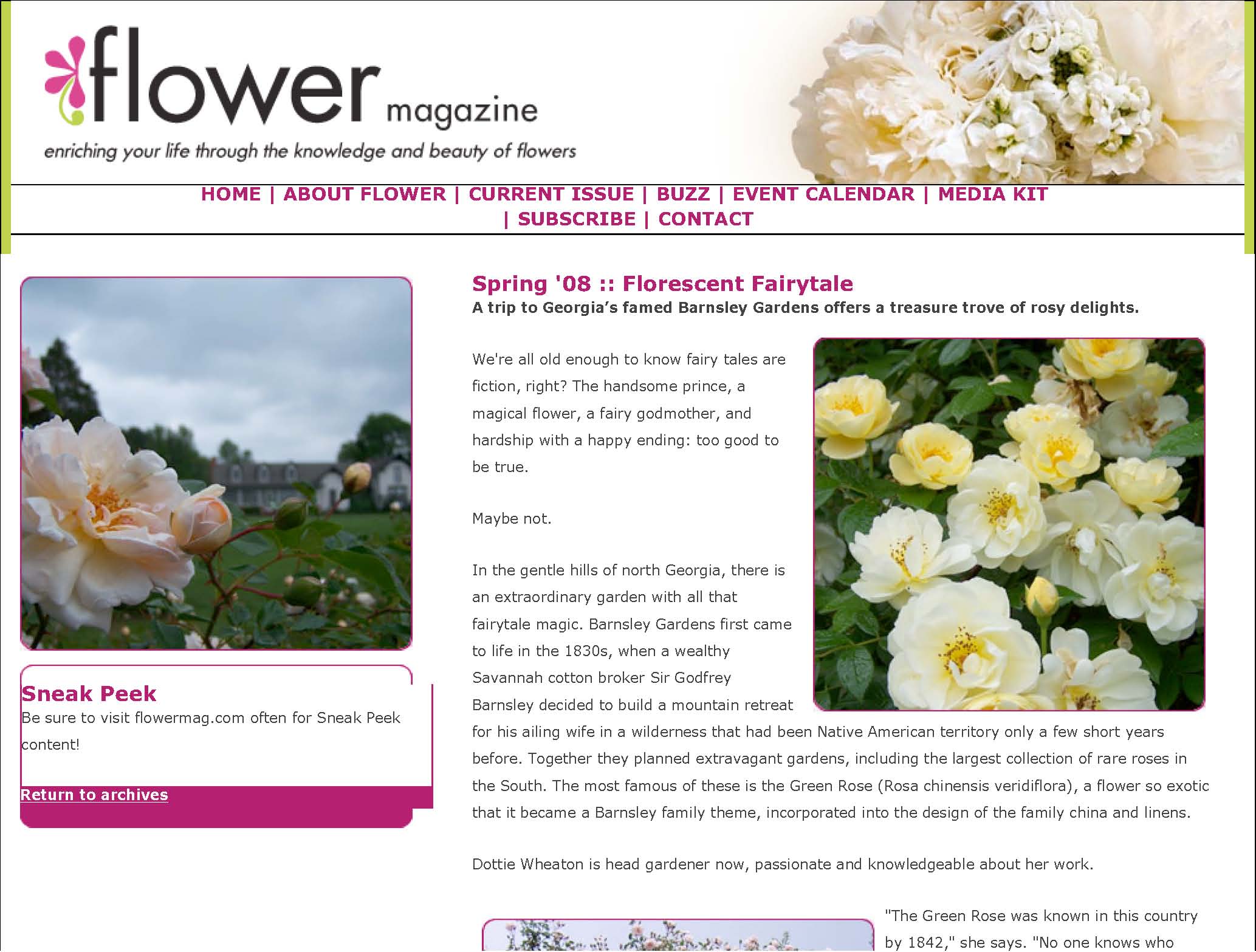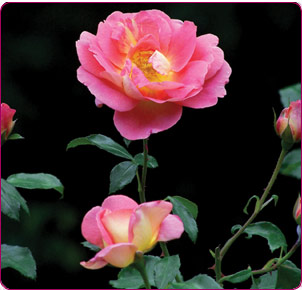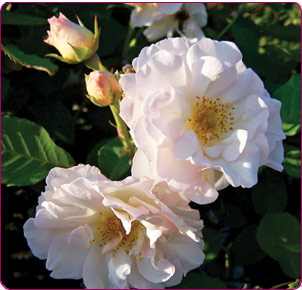Our Winter Issue hits the stands this month!

It is still grown at the Gardens today, a modestly-sized rose that resembles a crumpled bunch of green leaves more than anything else.
"It has a really unique scent," describes Barnsley's head horticulturist Michael Ferguson. "Freshly picked, it smells just like pepper. It even makes me sneeze."
More than 150 other roses are grown at Barnsley at present, many of them heirloom varieties. Alas, Mrs. Barnsley died before the estate was completed, and her cotton broker husband became despondent and abandoned the project. But his wife returned to him in a vision and urged him to carry on, which he did. Some of the roses he imported from all over the world survive to this day.
"His granddaughter Addie Saylor gave cuttings to many of her friends and neighbors, and we've gotten cuttings from those plants to return many of the original roses to the gardens," explains Wheaton. "But still we have just a fraction of what they had in their rose garden."
They've also gone searching for the original flowers in old cemeteries and old home sites.
"It's been like a treasure hunt," says Wheaton, her green eyes aglow. "Like pirates, except roses are our booty."
Per Godfrey Barnsley’s request, the rose garden was planted in a parterre just off the master bedroom suite, flooding the rooms with their heady scent in spring and summer. Called Woodlands, the estate prospered through several generations, surviving the Civil War and Reconstruction. Early in the 20th century, however, the magic spell was broken. A tornado ripped off the roof of the Italianate manor, and the ill-fated Barnsley descendants were forced to live in the kitchen wing.
A lethal family argument between Barnsley's great-grandchildren finished the fairy tale for the first family of the estate. Addie Saylor, Godfrey's granddaughter, was left brokenhearted when one of her sons shot the other dead, then went to prison for his crime. No one was left to champion the estate In such a state it may have remained had a prince not come to the rescue. Prince Hubertus Fugger of Bavaria, genuine royalty, was looking for investment property in the United States. Hearing about the ruined estate and gardens, he bought them sight unseen. He promptly fell in love with Woodlands, lavishing money on the project, its investment value becoming a secondary consideration. More than several million dollars later, the gardens began to reclaim their former glory.

The main house was not rebuilt, its structure too far decayed. The ruins, hauntingly lovely, still stand, with gracefully arched windows and a crumbling three-story tower. This area has been designated an historic district, and includes the old springhouse and coach house. The plantings are historically accurate, down to the elaborate knot garden laid out in front of the house.
"The roses are all heirloom varieties in the historic district," head gardener Wheaton continues. "The plants are not necessarily that old, but the varieties were all available to Barnsley at that time."
The only rose still on the property when renovations began was the Barnsley Purple rose. It is a deep maroon in color, a genetic descendant of the Gallica rose and named for the Barnsley family, who first identified it.
"All gardeners look for that discovery," says Wheaton, since the person who discovers a new variety of roses is allowed to name it.
One of the largest rose plants today is the Lady Banksia rose. It has claimed two stories on the west side of the ruined manor house, its reddish twisted trunk as thick as a tree, canes reaching vigorously in all directions. The fragile white blooms soften the stark lines of what remains of the house. It provides a lavish fragrance in springtime.
A rose arbor, which is a favorite place for weddings, stands at the lower end of the formal lawn,
appropriately named "New Dawn,” and they bloom twice a year.
"In spring and summer it spits some blooms out, and it gives a really nice display in fall," Wheaton says. "It was the very first U.S. plant patented."
The Barnsleys also collected another oddity in the rose family with the Zephirine Drouhin, a thornless rose that grows ten to twelve feet tall.
"You can smell it from a hundred yards away when it blooms," Wheaton relates.
The Cherokee rose, Georgia's state flower, twines enthusiastically over and along the split-rail fence that marks the border of the historic district. Modern roses found in this fairytale village include the Lafter, a hybrid tea rose.
 "That's one of my favorites," attests Wheaton. "Ours is only three or four years old but it's like a wall of pearly apricot blooms. It's got an incredible scent, it's disease resistant and you don't have to coddle it."
"That's one of my favorites," attests Wheaton. "Ours is only three or four years old but it's like a wall of pearly apricot blooms. It's got an incredible scent, it's disease resistant and you don't have to coddle it."
Once the historic gardens began to recover, Prince Fugger and his staff started planning the resort. They wanted it to be in keeping with the manor house, so they looked to the same architect who had inspired Godfrey Barnsley.
Andrew Jackson Downing designed the landscape of the White House and the Smithsonian Institute among others, and advocated the creation of Central Park in New York. His architectural style was noted for steep gables and pointed-arch windows, and these features are incorporated in the guest cottages. They have a playful look to them, with whimsical round windows and gingerbread trim, making the grounds resemble a small village.
Each of the cottages is surrounded by its own themed garden. These include a rose garden, a butterfly garden with blooms to attract the nectar-gatherers and a cactus garden. But Wheaton and Ferguson put their own wry twist on some.
"The thyme garden has thyme in it, of course," says head horticulturalist Ferguson. "It's also got a sundial, morning glories and four-o'clocks, too. We like to have a bit of fun with it."
There you have it: a practically perfect fairy tale. What about the fairy godmother, you ask? She really exists, a sort of fabulous concierge who arranges romantic private dinners in the ruins, exciting late-night excursions to roast marshmallows for the younger crowd, and leaves gifts and notes for guests. Don't be surprised if you see her trailing a cloud of butterflies and children.

Spring 2008 | By Karyn Zweifel | Photos By Dottie Wheaton